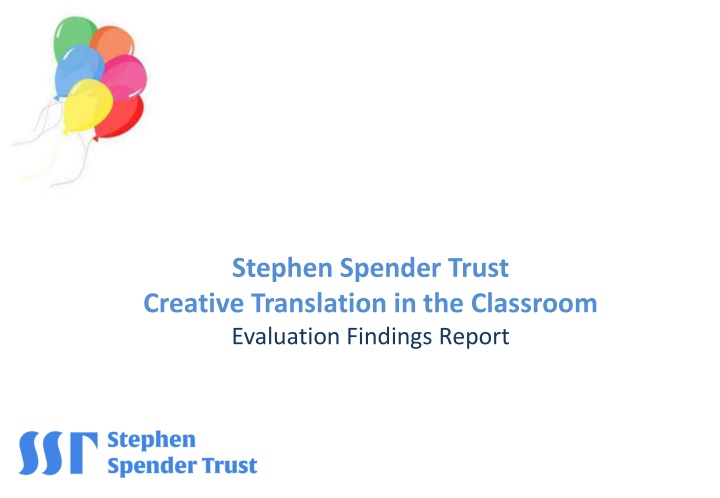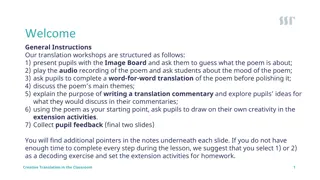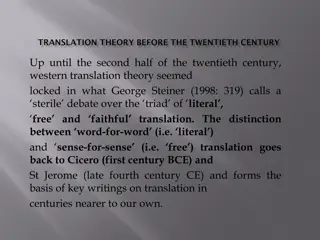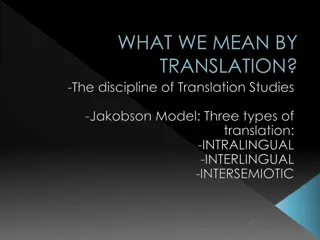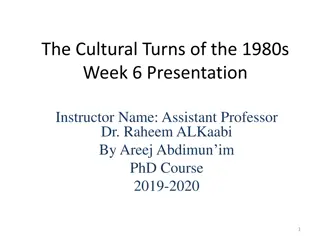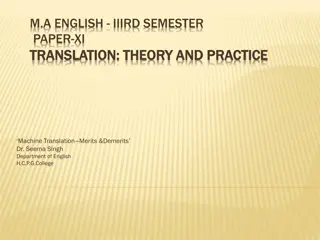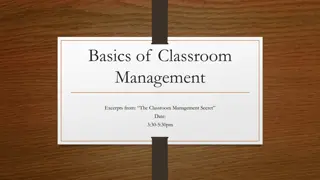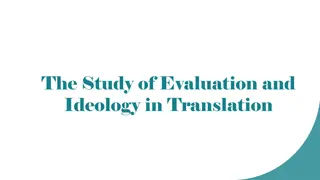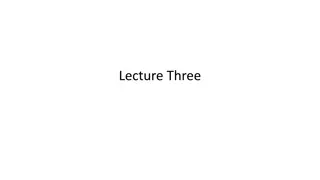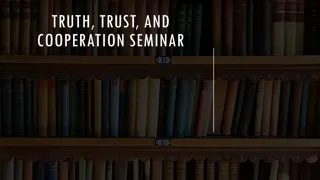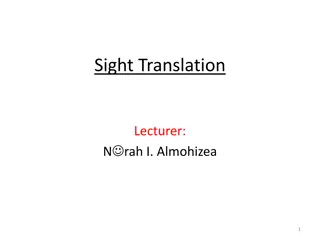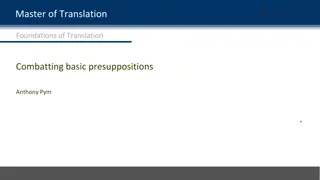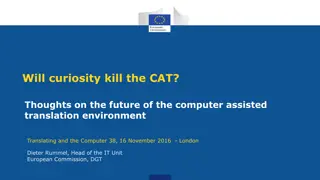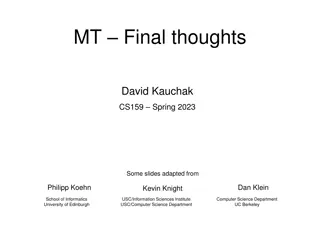Evaluation Findings Report on Creative Translation in the Classroom
The report presents a comprehensive evaluation of the impact of creative translation workshops on young people conducted by teachers and professional translators. It includes quantitative and qualitative feedback from students, observations by educators, and insights from translators, highlighting the benefits and outcomes of the program.
Download Presentation

Please find below an Image/Link to download the presentation.
The content on the website is provided AS IS for your information and personal use only. It may not be sold, licensed, or shared on other websites without obtaining consent from the author.If you encounter any issues during the download, it is possible that the publisher has removed the file from their server.
You are allowed to download the files provided on this website for personal or commercial use, subject to the condition that they are used lawfully. All files are the property of their respective owners.
The content on the website is provided AS IS for your information and personal use only. It may not be sold, licensed, or shared on other websites without obtaining consent from the author.
E N D
Presentation Transcript
Stephen Spender Trust Creative Translation in the Classroom Evaluation Findings Report
Summary of information collected (1) From students Quantitative feedback from sessions throughout the year from (approx.) 421 students (969 responses) Qualitative feedback from the same group Ad-hoc feedback shared with translators or teachers Observations made by teachers, translators and the evaluator From teachers and schools Two telephone interviews with the main case study school teacher Three additional interviews with teachers from the same school Informal conversations with other language teachers from the case study school Observation of a school meeting with seven language teachers from the same school Survey responses from 12 teachers (across all three years of the programme) Notes from two learning sessions at the July Celebration Event with eight teachers Some informal sharing over email from teachers 26 session monitoring forms including observations and reflective comments (seasonal: 17, summer: 9) 2
Summary of information collected (2) From translators Two interviews with the case study school translator Observation of one classroom session and one school meeting, delivered by the same translator Survey feedback from four translators A reflective learning session with four translators 18 student session monitoring forms including observations and reflective comments from the spring workshops 8 assembly session monitoring forms including observations and reflective comments 7 teacher showcase session monitoring forms including observations and reflective comments Email correspondence and sharing From the project team Two interviews with the Director (Charlotte Ryland) A team reflective session with the Programme Manager (Stacie Allan) and Programme Assistant (Rosie Eyre) Email correspondence and sharing A discussion of the evaluation findings (this document) 3
Outcome 1: By July 2022, 3000 young people in multilingual classrooms and community groups will have benefited from creative translation workshops and projects co- developed and -delivered by their teachers and professional translators. The following slides share findings for this outcome broken down by: a. The number of young people who have benefitted from the creative translation workshops sessions from teachers and translators across all three years How the young people have benefitted, structured by the project s priority student outcomes, with a focus on Y3 and references to findings from Ys 1+2 b. 4
Outcome 1a: the number of students who benefitted Year Activity Students Total 14 translator-led workshops in 4 primary, 3 secondary and 2 Saturday schools 388 Further teacher-led creative translation activities including assemblies, SST Prize entries etc.. 1 550 60 Workshops led by PGCE students or NQTs 102 9 teacher-led workshops in 2 primary and 5 secondary schools (Seasonal) 9 teacher-led workshops in 2 primary and 5 secondary schools (Spring) 5 teacher-led workshops (4 with remote translator support) and 2 translator-led workshops in 2 primary and 5 secondary schools (Summer) 2 265 265 In total there were 26 translator-led workshops in 2 primary and 6 secondary schools, with some being delivered to more than one class per school, and some variation in schools per term. 16 teacher-led workshops in 3 primary and 8 secondary schools (Seasonal) 18 translator-led workshops in 3 primary and 7 secondary schools (Spring) 9 teacher-led workshops in 3 primary and 8 secondary schools (Summer) 533 Further teacher or translator-led creative translation activities including assemblies, SST Prize entries etc.. (949 total but likely to include workshop attendees so 949 533 = 416) 5 3 2986 416
Outcome 1b: how students benefitted Structured by the project s priority student outcomes: 1. More engaged in language learning 2. Higher profile to multilingual students 3. More experience of working creatively or meaningfully with languages 4. More contact with professional translators 5. Increased intercultural engagement 6
Students: more engaged in language learning Overall this outcome has been met strongly in Y3, as in Ys 1+2 (see previous evaluation reports for further detail). The scale of the reaction shows the importance of doing this kind of thing. teacher Some teachers commented on the ability of students to focus more than usual. The student s perspective also came through in some of their qualitative feedback. (This was different from a normal language lesson because) there was more stuff in english and there was less being told to be quiet. secondary student There were particular benefits for those who are stronger (they could go further) and those who can struggle (support such as the glossary removed some barriers). For [students] at the higher end of the scale it s just been enriching. They ve enjoyed exploring poems and stories, and a break from the normal lessons. teacher Some of the normally weaker students were quietly engaged in the tasks and had more confidence to offer their ideas than in a normal language-learning lesson. teacher 7
Students: more engaged in language learning Students also commented on this new-found confidence, (Something I learned about languages was) you don t need to know all the words; find the ones you do know and work from there. - secondary student (I was surprised by) that I could translate! primary student (I was surprised by) the fact that we re translators! secondary student and in a few cases, changed attitudes to language learning. (This was different from a normal language lesson because) I don t mind learning French any more. secondary student Despite this, it won t work for all students, with some being just less engaged in languages (teacher). 8
Students: more engaged in language learning In Y3, 72% of students agreed that I understand more about how different languages have different rules and different ways of saying the same thing . This was higher in secondary than in primary schools. For all schools, students mentioned new insights into language, including new words, sentence structure or pronunciation, with moderate frequency in their open feedback. Translators who used slang commented how interesting students found this. (The best bit was) translating from French to English it was interesting to see how a sentence was structured secondary student (Something I learned about languages was) there are so many languages you can learn and in each of them there are different ways of expressing thoughts and feelings. secondary student 62% of students agreed that I ve done enjoyable activities with languages in a new way . While only 58% agreed that I m more interested in learning languages now , this can be viewed as a positive result given recent falls in interest in languages overall nationally, as well as the challenges of language learning under the current curriculum described by many teachers and students. 9
Students: more engaged in language learning Teachers and students described a range of ways in which the creative translation sessions were engaging. These included: The simple fact that this was different to a usual lesson. Lessons have a different atmosphere - a bit of a buzz when doing something different like this. - teacher Being able to translate a text or explore translation as a skill was the most frequently mentioned positive aspect of the session by secondary students, and the second most by those in primary school (The best bit was) translating sentences and playing with the words in order for them to make sense. - primary student Students were also able to play and have fun with the translation and linked activities we were able to put our own fun twist onto them to make the sentences more fun to write out. secondary student (The best bit was) we were able to look at a text and decipher it by ourselves at our own time and then 10 (The best bit was) I liked the drawing but the most fun was the translating. - primary student
Students: more engaged in language learning The structure of the task of translation (using the decode, translate, create model) They see it as a task, they can see the beginning middle and end. teacher The use of practical creative tasks such as lantern making or cooking, as well as the use of story, music, song and poetry. For primary students in particular these factors were mentioned the most frequently in their open feedback. (This was different from a normal language lesson because) using the french we learned we managed to make something cool. secondary student It was clear to me that many students were drawn in and engaged [by the song] regardless of their usual attitudes to learning French. teacher This was supported by comments from one translator, that for primary students at this age they engage more with storytelling, cultural difference, new information about sounds. The ability to extend the task, for instance into cooking at home or, in one case, sharing the ideas of creative translation more widely. Some of our students loved making their own "promotional" video of the Translation Workshop sessions, as they wanted to reach a wider audience. They adapted their own computer, video, editing and presentation skills to that effect. - teacher 11
Students: more engaged in language learning The structure of the sessions overall, with longer time given to each task, and a greater variety of activities, in contrast to what seems to be a normal language lesson s rapid pace and focus on testing or copying things down. (This was different from a normal language lesson because) it s all one text and it was the main focus (This was different from a normal language lesson because) we did a lot of discussing instead of writing everything down and we did a lot of little activities that were fun and not just writing down what was on the board. secondary student Many students also enjoyed working in groups. secondary student (The best bit was) working as a group, all of us contributing ideas to make a natural translation. The way an authentic text gives a third point of focus around which teachers and students could collaborate, breaking up the student-teacher binary and possibly reducing some tension by giving some respite from an entrenched pattern. They really enjoyed it because it was less teacher-centred. teacher The sessions allowed me to take a step back, talk to the students and see what they were doing without having to be so much in control. Freedom to connect with the students. - teacher 12
Students: higher profile to multilingual students Evidence for this outcome is limited this year, as in Ys 1+2 (see previous evaluation reports for further detail). A number of factors may have contributed, most notably that in some classrooms there were few or no children with English as an additional language (or EAL). Some schools (e.g. grammars in Buckinghamshire) provide no EAL support (or supportive culture), meaning that EAL children can feel shy or even hide their home/ additional languages, making it tricky to celebrate them and their knowledge. When it does work, however, it works well. Supportive factors included: Having more than one EAL speaker in the class The text for the session being in their language Including discussion or activities that explicitly value multilingualism (e.g. Rahul s intro exercise) The school (and/ or teacher) valuing EAL/ providing EAL support In one school, where many of these factors were present, Romanian-speaking students enjoyed sharing their knowledge with the class. (This was different from a normal language lesson because) we get to talk in our own languages and teach the teacher. primary student It gave EAL students an opportunity to excel and be mentors in the sessions specifically my two Romanian students. teacher (of the same class) In another school, students requested that further languages (their languages) be included in future sessions. 13
Students: higher profile to multilingual students One teacher reported using the session to begin to change the school s culture, at least within her classroom. Through this I ve been able to empower EAL students who are otherwise ignored... They ve been able to acknowledge that having another language is a power for them. - teacher In some cases the creative translation sessions could feel like a barrier for EAL students, due to their limited reading or speaking experience and therefore vocabulary in English. This challenge was also recognised by a language teacher, not a native English speaker, for her own ability to support students during the create part of the poetry translation process. 14
Students: more experience of working creatively or meaningfully with languages Alongside engagement, this has been one of the most strongly achieved outcomes across all three years of the project. Students and teachers enjoyed the ability to work with a real text, to express themselves, and to operate (however briefly) in a language-learning context in which there was no right answer. 61% of students agreed that I ve tried out new ways of coming up with my own ideas and answers. This was higher for primary than for secondary school students in the voting (quantitative) responses, although creativity or getting to do your own version was appreciated far more by secondary students in their open (qualitative) responses. Many students surprised both themselves and their teachers. I said ok for homework, these two lines we got a really nice variety of quite thoughtful and sweet responses, some really quite creative, gone further than I imagined from the original. teacher (I was surprised by) how we figured out what the poem meant even though it didn t make sense at the beginning. primary student 15
Students: more experience of working creatively or meaningfully with languages Many students commented on the creative aspect, and the freedom that this gave them. (This was different from a normal language lesson because) I was able to express myself and be more creative with my writing, and I enjoyed it. secondary student (This was different from a normal language lesson because) we were doing something creative which mixed both creativity and language skills. secondary student These benefits were most easily enjoyed by students who enjoy writing in English while for those who either don t, or may struggle due to a lack of vocabulary or experience, they could be less accessible. Some took particular delight in the lack of a right answer. (This was different from a normal language lesson because) we usually would translate something and mark it but we didn t mark this since there wasn t a right or wrong answer. secondary student All of these translations are perfect! teacher This was effectively modelled by at least one translator bringing in an English translation of their text, to show them at the end that there is no wrong or right and that translators always have to make choices. - translator 16
Students: more experience of working creatively or meaningfully with languages As well as being valued in themselves, these factors seemed to provide a profound break from the norms of a UK curriculum based language lesson. In both structure and content these can be experienced as limiting. (This was different from a normal language lesson because) we weren t learning new vocabulary but properly translating. secondary student (This was different from a normal language lesson because) we made things rather than repeating words meaninglessly. secondary student One translator also observed this, noting French activities are always prescriptive and to do with repetition and vocabulary whereas English class is where they can be creative they were really surprised that this was a French session made me realise how NOT fun they find language- learning in school. Teachers are of course all too aware. Creativity its being killed in ourselves and being killed in our students. - teacher 17
Students: more experience of working creatively or meaningfully with languages Students and teachers both appreciated working with real texts. (This was different from a normal language lesson because) it was more interactive and I enjoyed it was a poem and something actual in media that is interesting. secondary student (This was different from a normal language lesson because) we were translating a poem instead of just random sentences. secondary student Authentic texts are better than textbooks and great for cultural conversations and classroom enrichment. Better than manufactured GCSE texts. GCSEs teach exams, not culture. teacher They actually get interested because they re dealing with something real. Even if they have to work a bit harder at it. - teacher 18
Students: more contact with professional translators This outcome has been achieved well over all three years through the delivery itself (see previous evaluation reports for further detail). In this third year, at least 533 students had live contact during the Spring sessions, with more seeing the translator over video during the seasonal and summer sessions, and 949 having additional (if brief) contact through assemblies. Teachers described the presence of the translator as making a huge difference to the class in terms of engagement on the day, as well as attitudes to languages more broadly. In some cases this seemed simply about having a break from the norm, having a visitor, or the personal touch . It made some students, or classes, feel special. In others it helped to make the case for the wider relevance of languages in life outside of school, or in the future, for instance for travel or careers. Meeting a translator had a big impact on my classroom. Someone else talking about the real world it s a different dynamic. - teacher 19
Students: more contact with professional translators Translators reported that their additional sessions (the assemblies) gave them the opportunity to speak with students about the use of languages more broadly in work and life, for instance working for companies in different countries, or when travelling. When older students thinking about their degrees, or sixth formers who had already decided to study languages were present, there was even greater engagement. It s notable that while the role of the translator was greatly emphasised by teachers, it was barely mentioned by the students themselves in their open (sentence completion) feedback. This may be through a lack of self-awareness, or the ability to reflect on the wider context of their learning, which is understandable given the ages of the students involved. Please note that we did not specifically ask students for feedback on the translators' involvement. 20
Students: increased intercultural engagement In the first year of the project, this was (along with priority student outcome 2), one of the outcomes for which there was little evidence. The changes to the delivery model (for instance more sessions, more material, and more teacher-led activity) increased the time given to the cultural aspect, and this is reflected in the increased evidence for this outcome across Ys 2+3 (see previous evaluation reports for further detail). The greater attention given to gathering student feedback in these years may also be a contributing factor. In Y3, 78% of students agreed that I learned things I didn t know before about other languages and cultures . This was higher in primary than in secondary schools. This wider reach into the intercultural, interdisciplinary and extracurricular aspects of language learning and use was a huge part of the session s appeal for many students and mentioned frequently in their open feedback. (This was different from a normal language lesson because) instead of learning et, un, c est etc.. we were learning about cooking ingredients and history and geography. secondary student Some teachers noted that students were respectful of one another s cultures and traditions, in the more diverse classrooms. 21
Students: increased intercultural engagement Students enjoyed learning new facts and ideas, (The best bit was) discovering the flag from Haiti: it is really nice!. primary student and were particularly struck by those that challenged their existing assumptions or knowledge, for instance about Christmas; [They] got very excited about the Caribbean Christmas, loved the song. Some couldn t get their heads around it that this was a Christmas song gave rise to an interesting discussion idea that things are done differently in different parts of the world. - teacher or about where different languages are spoken; (I was surprised by) we learnt some French things from a country which was not France. primary student (Something I learned about languages was) loads of countries have multiple languages. secondary student 22
Students: increased intercultural engagement It could make languages feel more relevant and part of real life. (This was different from a normal language lesson because) we did something that links French inside the classroom to French outside the classroom more clearly. secondary student (This was different from a normal language lesson because) we did more activities and explored the language in a more realistic way. secondary student These insights extended into the relationship between culture and translation, for some. (Something I learned about languages was) that translators need to understand culture. secondary student (The best bit was) I think translation is a good way to understand other people. primary student (Something I learned about languages was) how much culture influences word choice. secondary student 23
Students: increased intercultural engagement Teachers also enjoyed being able to bring cultural aspects into the classroom more; As language teacher the thing that s most fun is getting them to engage with cultural material. - teacher and particularly valued the use of authentic texts as a way in. Authentic texts are a great way to bring up discussion and route into the cultural conversation. - teacher 24
Outcome 2: By December 2022, 25 teachers and community leaders will be fully trained and experienced in using translation creatively in their classroom practice, and in involving the families of their EAL students in that practice. They will have access to print and digital resources to sustain that practice. The following slides share findings for this outcome broken down by: a. The number of teachers and community leaders fully trained and experienced in using translation creatively in their classroom practice How teachers have benefitted, structured by the project s priority teacher outcomes, with a focus on Y3 and references to findings from Ys 1+2 Teachers access to print and digital resources to sustain their practice will be discussed under Outcome 3 b. c. 25
Outcome 2a: teacher numbers (Y1) Year Activity type Number of teachers Total Teachers trained at the October 2019 CPD day 14 Trained by the project: 20 Students/ newly qualified teachers (NQT) trained at the October 2019 CPD day 6 Trained or reached directly by trained teachers: 25 Other teachers reached through talks or in-school advocacy 5 Teachers co-delivering (8) or supporting (14) translator-led sessions 22 1 Experienced through translator co-delivery: 22 Teachers/ students/ newly qualified teachers (NQT) delivering independently 2 Experienced through independent delivery: 2 Trained directly by the project and experienced through translator co- delivery: 10 26
Outcome 2a: teacher numbers (Y2) Year Activity type Number of teachers Total Teachers trained as part of the school cohort 10 Trained through the project: 35 Teachers trained remotely 25 Other teachers trained by their peers 1 Trained or reached directly by trained teachers: 13 Teachers reached through a showcase event 12 2 Teachers co-delivering (8) or supporting (7) translator-led sessions 15 Trained directly by the project and experienced through translator co- delivery: 8 Trained and experienced through the remote strand: 9 27
2a: teacher numbers (Y3 + total) Year Activity type Number of teachers Total Teachers trained through intro session (15) and webinar strand (12) 27 Trained directly by the project: 27 Other teachers reached through talks or in-school advocacy, including assemblies and showcase events 72 (across both the assemblies and the showcase sessions; possibly some duplication) Trained or reached directly by trained teachers 72: Teachers co-delivering (15) or supporting (13) translator-led sessions 28 3 Experienced through translator co-delivery: 28 Teachers delivering independently having been trained through the webinar strand (9) or learning from their colleagues (4) 13 Experienced through independent delivery: 13 Trained directly by the project and experienced: 24 Teachers trained directly by the project and experienced: 42 3-year total (target: 25) 28
Outcome 2b: how teachers benefitted Structured by the project s priority teacher outcomes: 1. Greater ability to engage students in language learning/ multilingualism 2. Greater ability to use translation creatively 3. Greater access to creative translation resources, including classroom activities and the Prize (reported against overall outcome 3, below) 29
Teachers: greater ability to engage students in language learning/ multilingualism Feedback from interviews, group discussions and email contact with teachers in Y3 suggests that this outcome has been met well, as in Y1, at least with regards to language learning. There was less evidence in Y2, perhaps due to the limited direct contact teachers had with translators throughout that year, and on-going disruption due to COVID restrictions (see previous evaluation reports for further detail). In Y3 we ran a survey including all of the teachers from the whole project. 10 out of 11 teachers responding to the survey agreed that I have learnt new ways to engage students in language learning . 8 out of 11 teachers responding to the survey agreed that I feel more able to engage with multilingual students , with one adding that the Urdu spotlight raised both the language s profile and the importance of children s home language skills. There was little feedback on this outcome from other individual or group conversations in Y3, although at least two teachers enjoyed the opportunity sessions gave for some EAL students to shine. If future projects include this outcome it could be useful to create specific activities with this in mind. 30
Teachers: greater ability to use translation creatively This outcome has been met well across all years (see previous evaluation reports for further detail). 10 out of 11 teachers responding to the survey agreed that I feel more confident to use translation creatively . 8 out of 11 teachers responding to the survey agreed that I have improved or new skills , with the new skills mentioned including: Using challenging texts with middle ability students Using literal and creative translation Enriching language teaching with cultural content Leading sessions even in languages that are not well known (including by the teacher) 31
Teachers: greater ability to use translation creatively Teachers enjoyed looking at translation as a skill, and encouraging students to do the same. I love the fact that we are giving them permission purely to focus on the skill of translating. teacher Many teachers described their intentions to embed creative translation in their practice more broadly. In at least five cases this was already taking place, particularly where they had the support and interest of their colleagues and wider school leadership. It s been a real tonic and given me so much that I will take into my future teaching given me an exercise to chuck in a bit of authentic text, and something tangible to do with it. teacher This year there has also been more of an emphasis on sharing practice within schools, through showcase sessions and other support. This has resulted in some cases in the practice spreading to other colleagues, and in one case creative translation and authentic texts being adopted by a whole department as part of the normal scheme of work for every class. Please see the case study for more detail. 32
Outcome 3: By December 2022, sustainable networks of EAL and MFL teachers and community leaders in Buckinghamshire and Oxfordshire will be established, with links to national organisations and access to SST s resources, interactive website, on-going Translators in Schools programme and the SST prize as a focus for motivation and aspiration. Also from Outcome 2: They (teachers + community leaders) will have access to print and digital resources to sustain that practice, The following slides share findings for this outcome broken down by: a. b. c. Access to (and views of) SST s resources Access to the SST prize Networks, including links with national organisations 33
Teachers: access to resources The relaunch of the SST website (summer 2021) created a resource repository. In December 2021, 8 short activities were uploaded, including 5 seasonal activities from Y2 translators, and sent to the Y3 teachers. In March 2022, 7 poetry workshops and 6 poetry worksheets were uploaded ahead of the launch of the Prize. 10 out of 11 teachers responding to the survey agreed that I have greater access to creative translation classroom resources , with one commenting that one of the main benefits of the programme as been accessing excellent resources that use authentic texts. As a full-time teacher, it is difficult to find the time to source this material. Teachers throughout the programme have found the classroom resources excellent, with one describing them as well organised, vibrant and colourful. Another commented on the richness of resources (powerpoint, flag, book, paper, LED candles). Please see previous evaluation reports for further detailon resources. 34
Teachers: access to the SST Prize From Y2 onwards, the structure of the programme was explicitly linked to the Prize to help teachers support entries from their students. This resulted in an uplift in entries from programme schools, as follows: In Y2, 88 students from 4 Creative Translation in the Classroom (CTiC) schools entered the Prize. In Y3, 217 students across 10 CTiC schools entered In addition, one Y3 teacher and one teacher from a Y2 school were named as outstanding teachers for 2022. 8 out of 11 teachers responding to the survey agreed that I feel more able to support students to enter the Stephen Spender Prize , with one mentioning the prize as a way to get the whole school involved in creative translation, and another also mentioning the Anthea Bell Prize. Teachers appreciated the variety of languages on offer, including for multilingual students wanting to look for sources in their languages. The online support was described as easy to navigate, including for students. 35
Teachers: networks 6 out of 11 teachers responding to the survey agreed that I know more people involved in creative translation . This may have included people within and outside school. In at least one school, creative translation has flourished across the whole MFL faculty, with resources and support from leadership. This has created an internal network of practice (see the case study for more detail). An authentic text group has emerged from the 20 or so teachers originally involved in Y2 s remote strand , meeting once in June 21 (approx. 20 attendees), with some members also attending the June 22 celebration event. Working with colleagues is helpful, especially those who have done the same thing. teacher This group is keen to continue to meet and share practice, although the limitations on their time and energy are significant. SST is exploring different ways to support them, going forward. I mean it was interesting to chat at the meeting but [you need] to be realistic about what you can fit into a day s work. teacher 36
Teachers: networks In addition, a group of approx. 12 teachers trained through the Y2 webinar strand are continuing a dialogue with SST, with a particular interest in using creative translation as part of efforts to decolonise the curriculum. Throughout the programme, links have been made with national and international networks and other programmes, including: Association for Language Learning [ALL] ALL Special Interest Group in Decolonising the Curriculum NALDIC (Subject Association for EAL) PGCE Providers for Modern Languages Independent Schools Modern Languages Association Queen s College Translation Exchange Mediterranean Editors and Translators' Meeting 2022 37
Successes, challenges and recommendations The following slides share learning and on-going questions around the project s successes and challenges. They have been put together following: Review of the Y3 report findings and in light of prior years' recommendations Discussion with Charlotte, Cat and Milla at a reflection meeting in January 2023 38
Successes: at the school/ project level Successes Questions/ reflections/ recommendations for embedding creative translation in schools Most outcomes met effectively, with EAL one of the weaker areas Separate out EAL and MFL as the needs and processes are so different, including partnering with other groups, (e.g. the developing work with refugee organisations) Supporting MFL activities in schools the model works well Continue, while building up teacher and school remote support and resources, while acknowledging that face to face training is most effective, where it's possible Making the model more sustained and teacher-led (general move across Ys 1 2 and again Ys 2 3) has supported more effective outcomes Continue, while building up teacher and school remote support and resources. Translator visits as occasional additions/ cherry on the cake. Successfully embedding the Prize in the SST programme Consider adding in Anthea Bell Prize process elements, for instance a bank of poems, a more embedded scheme of work throughout the year. Look at bringing AB Prize and Stephen Spender Prize together for teachers. 39
Successes: at the school/ project level Successes Questions/ reflections/ recommendations for embedding creative translation in schools Finding schools where there s both an enthusiastic and capable lead teacher, and supportive leadership You need both an invested teacher and a supportive SLT team member Have clear criteria for school selection and communicate clearly about them. For instance Genuine enthusiasm from the lead teacher, so that they are choosing to participate (not being volunteered) Support from SLT Time made available for teachers to train and deliver the materials (with clarity on the actual time required so it doesn't become an additional workload for teachers) Suggest that teachers are recognised through their line management/ other professional development avenues for their additional commitments to creative translation and extra effort delivering the programme The project might support these criteria being met initially and then upheld by: Developing an explicit MOU with schools (signed by head + teacher) in order to hold them to account/ advocate for the programme throughout the year Explaining the benefits to SLT/ others in language that fits with their own pressures and targets, including mapping to curriculum, OFSTED etc., attention to trends and buzzwords (e.g. currently cultural capital ) Develop additional comms for SLT, and for school marketing/ external comms people to adapt/ use, emphasising the curriculum and wider benefits of the programme, in terms that are meaningful to the audience(s) 40
Challenges: at the school/ project level Challenges Questions/ reflections Running the whole show (team member) supporting delivery in schools has been resource-intensive for the team. Options include working more with delivery partners, and/ or working more strategically with national partners, or continuing to work more remotely, with enthusiastic schools/ teachers/ groups The schools with the highest needs (where funding can require focus) can be the most stretched and least able to collaborate. Clarify this with funders and seek additional support to enable their engagement. Focus on showing/ sharing impact of longer projects in schools with higher needs (e.g. some primaries) Teachers are overburdened in general with curriculum and other demands and have barely any time for communications or development work. Opportunistically fit activities more closely to curriculum demands, at the scheme of work level. Potentially parcel up resources into mini courses that slot clearly into the curriculum and schemes of work. This could also enable the materials to be shared throughout/ earlier in the term, rather than solely as a standalone 'extra' activity. Continue working with and through existing teacher networks 41
Translator + teacher successes and challenges Successes/ challenges Questions/ reflections Building the relationship early on, ideally face to face Recommend this/ include in translator training/ guidance For teachers, providing twilight training sessions (e.g. 4.15 5pm) with plenty of opportunities for them to speak with one another in breakout rooms Continue Translators would value more opportunities for detailed peer support and feedback both during session development, and following delivery. Consider offering this (distinct from general peer support), perhaps following the QTE Ambassador model of observation and peer feedback Delivering at the end of term may have appeared to allow more time and space for the sessions, but in some cases students may have lost focus, while everyone felt tired. Consider fitting the workshops in earlier in the term/ recommending this 42
Classroom successes and challenges Successes/ challenges Questions/ reflections Often not enough time, particularly for the creative stage. (this feedback was shared by translators, teachers and students) Maintain the 1.5 hour minimum for workshops On teacher reported that her students had limited understanding of poetry, creating unexpected barriers for the create stage of the process. Provide some more guidance and teaching materials Start creative translation even earlier, with tasters in the years leading up to the year with the main workshops, to build familiarity of the process and the types of texts. I was surprised how much we had to go over the basics of poetry rhyme, metre what distinguishes a poem from prose, really. - teacher Explore building up a cross-curricular approach with English, including sharing how creative translation and the Prize can be relevant to the English curriculum Some teachers felt a tension between encouraging student creativity, and the need to teach for the exam where such creativity could lose marks. Provide support materials around this? If [students] think too much outside the box they will end up getting penalised. I m not sure how to guide them. - teacher 43
Other recommendations from teachers Teachers A visual map of the whole year s activities/ support, leading up to the Prize Support/ documents to sell the project to SLT and encourage them to make it part of line management/ development plans Some more differentiation within sessions, including shorter tasks for the less able Links to celebrations/ holidays a good meaningful activity rather than just a poster on French Christmas. - teacher Topics that link to the KS3+4 + Alevel themes, such as food, health, lifestyle, school etc.. More practical activities (such as the lanterns), which worked well 44
Other recommendations from students Students More time esp to complete polished translations More entertaining/ creative/ fun/ varied (primarily for teacher-led sessions) More frequent sessions on translation More practical tasks and activities More varied or interesting texts (primarily for poetry sessions) Easier/ shorter pieces of translation Able to choose our own groups More group work
Evaluation recommendations, looking ahead Basic foundation Maintain quantitative info collection from students (e.g. the voting) and facilitator/ teacher feedback (the session forms) for all delivery Additional insight Pick a smaller number of schools to add in the qualitative element (e.g. student sentence completion, a handful of facilitator/ translator interviews) Deep dives Consider looking at a particular angle or question in more depth every year or two, perhaps through the impact internship/ external evaluator, to inform learning, communication and future project/ organisational development Publication Consider collaborating with academic researchers every 2 3 years to publish a scholarly paper, starting from insights from any of the above, and developing them further
